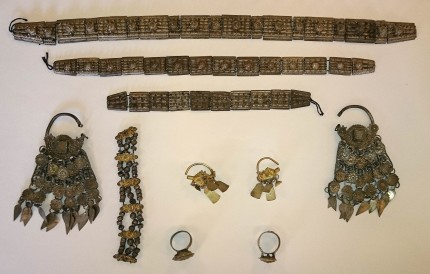
A treasure of silver jewels buried in the 17th century has been found near the northwestern Bulgarian city of Montana. The hoard was discovered by local residents who very responsibly reported the find to the National Museum of History in Sofia. There’s a tiara, two forehead bands, two ear tabs, connectors between the headpieces and the ear tabs, a pair of earrings and two rings. They are all made of silver and are of very high quality, decorated with expensive, highly skilled techniques including filigree, granulation, niello, gold leaf and a green glass-like mass that is probably enamel. The objects were placed in a leather purse, surviving fragments of which were found at the site.
The jewelry is almost certainly local work. The area was known for its very fine gold and silversmiths. The work of the Chiprovtsi smiths was famous all over Eastern Europe for its complexity and delicacy. They had access to a steady supply of precious raw materials, thanks to local silver ore deposits which were extensively mined in the 16th and 17th centuries.
After the Ottoman conquest of the Second Bulgarian Empire in 1396, some areas were granted the right of Christian self-government, among them the village of Chiprovtsi and neighboring towns. When silver ore was found in the region in the second half of the 15th century, the population of the villages swelled with Roman Catholics, Eastern Orthodox, Albanians and German miners while the old Catholic nobility appears to have ruled virtually undisturbed with only a token Ottoman representation in the municipal government. Chiprovtsi was closely linked to the Catholic ecclesiastical hierarchy as well. The official residence of the Catholic archbishops of Bulgaria was Chiprovtsi’s Monastery of St. Mary.
The mix of peoples, strong Catholic leadership and quasi-autonomy of the region spurred residents to seek to overthrown the Ottoman Yoke. The Chiprovtsi Uprising, a rebellion of Roman Catholic (and some Eastern Orthodox) Bulgarians against Ottoman rule, was precipitated by Austria’s capture of Belgrade from the Turks on September 6th, 1688. Chiprovtsi Catholics had been trying to induce the monarchies of western Europe to take Bulgaria from the Ottomans for more than four decades, coming very close several times to triggering elaborate invasion plans that ultimately fell through. When Belgrade fell to the Austrians, the Chiprovtsi rebels thought that after so many false starts, the moment had finally come. Hopeful that the Austrians would send reinforcements to support the uprising, extend their victory east and ultimately liberate all of Bulgaria from Ottoman rule, the insurrectionists rose up and fought the Ottomans and their Magyar allies.
It did not go well. There was no coordination between Austrian and Bulgarian forces, and the Turks handily won the military encounters. The decisive battle took place near Montana, then called Kutlovitsa, in October of 1688. The Ottomans won decisively. They captured Chiprovtsi on October 18th and razed it to the ground, killing almost everyone and enslaving whoever survived. While a much-reduced guerilla resistance continued for a few months, the Austrians never came and much of the remaining population fled west to the Danube or north to Wallachia. Archbishop Peter Knezevic led the emigration to Wallachia. Few Christians remained in the northwest and the Ottomans ruled directly, stripping the Bulgarian nobility of their old privileges and political power.
The National Museum of History experts believe the cache of silver jewels was a family fortune buried in the turbulent days of the Chiprovtsi Uprising in the fall of 1688. Since almost everyone in the area was killed in battle, executed, enslaved or fled, there was nobody left to dig up the treasure.
while I enjoy hoards, I always find them a bit sad. lord knows what tokens of wealth I would bury, knowing I or my family may not survive to dig it up.